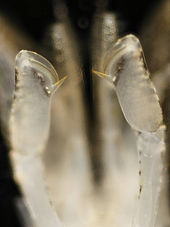Crangon crangon
| Crangon crangon | |
|---|---|

| |
| Scientific classification | |
| Domain: | Eukaryota |
| Kingdom: | Animalia |
| Phylum: | Arthropoda |
| Class: | Malacostraca |
| Order: | Decapoda |
| Suborder: | Pleocyemata |
| Infraorder: | Caridea |
| Family: | Crangonidae |
| Genus: | Crangon |
| Species: | C. crangon
|
| Binomial name | |
| Crangon crangon | |
| Synonyms [1] | |
| |
Crangon crangon is a species of
Description

Adults are typically 30–50 mm (1.2–2.0 in) long, although individuals up to 90 mm (3.5 in) have been recorded. protruding.
Crangon is classified in the family
Distribution and ecology
C. crangon has a wide
Adults live epibenthically (on or near the sea-floor) especially in the shallow waters of estuaries or near the coast.[7] It is generally highly abundant, and has a significant effect on the ecosystems where it lives.[7]
Lifecycle
Females reach
Fishery
Historically, the commercial fishery was accomplished by horse-drawn beam trawls on both sides of the Dover straits.[10] In the sandy shallows of Morecambe Bay (Lancashire, UK) horses have been replaced by tractors. Some small fishing vessels also use beam trawls for brown shrimp. A few artisanal fishermen use hand-pushed nets. In all UK shrimp fisheries, the catch is first 'riddled' to release the young of shrimps and fish. The shrimps are then traditionally boiled on board before landing.
Over 37,000 t (82 million lb) of C. crangon were caught in 1999, with Germany and the Netherlands taking over 80% of this total.[1]
The UK lands an annual average of 1000 tonnes of brown shrimp, but the catch is highly variable between 500 and 1500 tonnes.[11] In the Lancashire fishery for brown shrimp it has been shown that landings in any year are related to the annual catch, average annual air temperature (inverse) and total rainfall in the previous year. That has enabled a good prediction of annual landings one year in advance.[12] Moreover, for the port of Lytham, the abundance of shrimp (annual catch per unit effort) was found to be closely correlated with the mean annual Zürich sunspot number for the period 1965-1975.[13] Given that sunspot numbers are predictable, this provides another tool for the prediction of annual shrimp catch. Sunspot cycle No. 23 (1997-2008) is a good example of the correlation between UK annual brown shrimp catch and mean annual sunspot number.[11]
Greenpeace Germany classifies the brown shrimp as an "unsustainable" choice that should be avoided.[14] Brown shrimp have been documented to contain microplastics.[15]
As food

The consumption of brown shrimp is popular in Belgium, the Netherlands, northern Germany, and Denmark.
Shrimp in general are known as garnalen in
In Lancashire, England, the peeled brown shrimps are mixed with butter and spices (including nutmeg or mace) to make potted shrimps, a dish traditionally eaten with bread.[17]
References
- ^ a b c "Crangon crangon (Linnaeus, 1758)". Species Fact Sheets. Food and Agriculture Organization. Archived from the original on May 27, 2020. Retrieved June 24, 2011.
- S2CID 80913454.
- ^ a b c "Crangon crangon". ARKive. Archived from the original on 2008-05-17. Retrieved June 24, 2011.
- .
- .
- ^ PMID 18207428.
- ^ S2CID 86803810.
- ^ )
- ^ Based on data sourced from the FishStat database, FAO.
- ISSN 2285-4177. Archived from the original(PDF) on 2015-04-02. Retrieved 2015-03-14.
- ^ .
- .
- S2CID 83763670.
- ^ "Fisch Einkaufsratgeber" [Fish Shopping Advisor] (PDF). Greenpeace (in German). January 2016. Retrieved 3 January 2023.
- PMID 26456303.
- ^ "Les crevettes grises" (in French). Eating.be. Archived from the original on October 11, 2012. Retrieved September 13, 2012.
- ISBN 0-7078-0357-8.
External links
- Joana Costa Vilhena de Bessa Campos (2009). The eco-geography of the brown shrimp Crangon crangon in Europe (ISBN 978-90-865-9350-7.
- Photos of Crangon crangon on Sealife Collection
